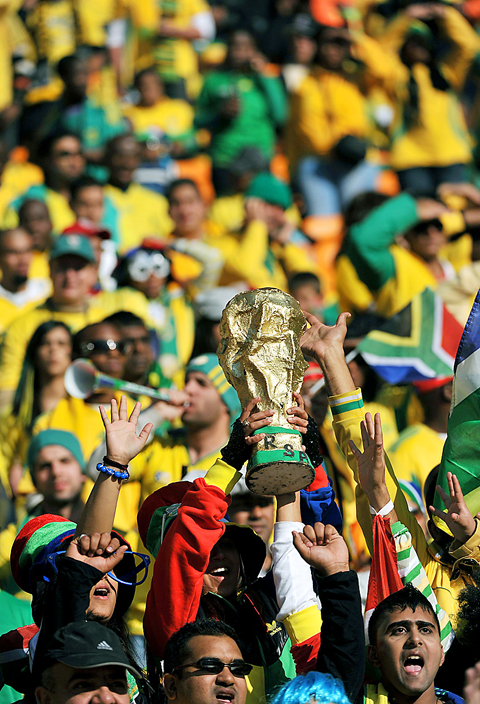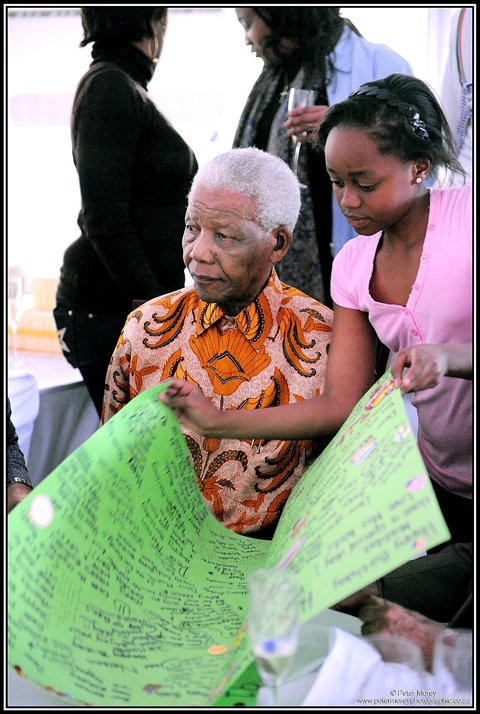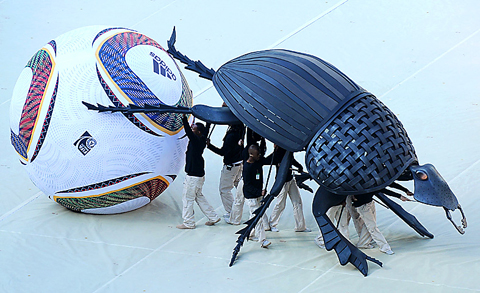Fighter jets sped low over Johannesburg’s Soccer City stadium, briefly drowning out the constant din of tens of thousands of vuvuzela trumpets as South Africa opened the 2010 soccer World Cup with a celebration of African culture.
The stadium, resembling a massive African cooking pot, erupted in cheers as performers took to the field to mark the first time that sports’ most watched tournament has been staged on the continent.
Reported traffic problems, though, delayed some fans, leading to the ceremony kicking off to many empty seats.

PHOTO: REUTERS
A giant dung beetle rolled a ball across the arena as Nobel Peace Prize winner Desmond Tutu danced in the stands and 1,500 performers jived to African music.
Boards displayed the colors of the 32 teams and banners pointed to the nine host cities while drummers beat a constant rhythm.
About 70,000 people, a sea of green and gold, South Africa’s national team colors, listened to songs from the six African nations in the tournament — South Africa, Nigeria, Ghana, Cameroon, Ivory Coast and Algeria — and Grammy winner R. Kelly’s anthem Sign of a Victory.

PHOTO: AFP
Pockets of Mexican fans waved banners and flags, many adding to the overwhelming noise made by vuvuzelas, the loud plastic trumpet that has quickly become a symbol of this World Cup.
But one of the loudest cheers was reserved for former South African president Nelson Mandela, whose image appeared on screens to a message of hope from him in song.
“The generosity of the human spirit can overcome all adversity. Through compassion and caring, we create ... hope,” he said.

PHOTO: AFP/NELSON MANDELA FOUNDATION
The 91-year-old Mandela, who led the country out of apartheid in 1994 and whose global stature helped win the country the right to host the World Cup, canceled an appearance at the ceremony after a great grand-daughter died overnight.
The Nelson Mandela Foundation said Zenani Mandela died in a car accident after attending the World Cup kickoff concert at the Orlando Stadium on Thursday.
Mandela and his family were “torn up” by the accident, the foundation said at its Johannesburg office.

PHOTO: AFP
“Mr. Nelson Mandela this morning learnt of the tragic death in an accident of his great-granddaughter Zenani Mandela,” spokesman Sello Hatang said, reading from a prepared statement. “It would therefore be inappropriate for him to personally attend the FIFA World Cup opening celebrations.”
“We are sure that South Africans and people all over the world will stand in solidarity with Mr. Mandela and his family in the aftermath of this tragedy,” Hatang said.
Johannesburg Metro police spokeswoman Edna Mamonyane said the driver of the car, a man, had been arrested and charged with drunk driving. Mamonyane said the driver, who police would not name, could also face culpable homicide charges.
“He lost control of the vehicle and it collided with a barricade,” Mamonyane said.
FIFA president Sepp Blatter wrote to Mandela to “convey the condolences of the entire football family.”
Zenani, who celebrated her 13th birthday on Wednesday, was one Mandela’s nine great-grandchildren.
Also See: 2010 FIFA WORLD CUP: PREVIEW: Argentina must answer critics
Also See: 2010 FIFA WORLD CUP: PREVIEW: England go into opener with something to prove

LONG FLIGHT: The jets would be flown by US pilots, with Taiwanese copilots in the two-seat F-16D variant to help familiarize them with the aircraft, the source said The US is expected to fly 10 Lockheed Martin F-16C/D Block 70/72 jets to Taiwan over the coming months to fulfill a long-awaited order of 66 aircraft, a defense official said yesterday. Word that the first batch of the jets would be delivered soon was welcome news to Taiwan, which has become concerned about delays in the delivery of US arms amid rising military tensions with China. Speaking on condition of anonymity, the official said the initial tranche of the nation’s F-16s are rolling off assembly lines in the US and would be flown under their own power to Taiwan by way

OBJECTS AT SEA: Satellites with synthetic-aperture radar could aid in the detection of small Chinese boats attempting to illegally enter Taiwan, the space agency head said Taiwan aims to send the nation’s first low Earth orbit (LEO) satellite into space in 2027, while the first Formosat-8 and Formosat-9 spacecraft are to be launched in October and 2028 respectively, the National Science and Technology Council said yesterday. The council laid out its space development plan in a report reviewed by members of the legislature’s Education and Culture Committee. Six LEO satellites would be produced in the initial phase, with the first one, the B5G-1A, scheduled to be launched in 2027, the council said in the report. Regarding the second satellite, the B5G-1B, the government plans to work with private contractors

‘NARWHAL’: The indigenous submarine completed its harbor acceptance test recently and is now under heavy guard as it undergoes tests in open waters, a source said The Hai Kun (海鯤), the nation’s first indigenous defense submarine, yesterday began sea trials, sailing out of the Port of Kaohsiung, a military source said. Also known as the “Narwhal,” the vessel departed from CSBC Corp, Taiwan’s (台灣國際造船) shipyard at about 8am, where it had been docked. More than 10 technicians and military personnel were on deck, with several others standing atop the sail. After recently completing its harbor acceptance test, the vessel has started a series of sea-based trials, including tests of its propulsion and navigational systems, while partially surfaced, the source said. The Hai Kun underwent tests in the port from

MISSION: The Indo-Pacific region is ‘the priority theater,’ where the task of deterrence extends across the entire region, including Taiwan, the US Pacific Fleet commander said The US Navy’s “mission of deterrence” in the Indo-Pacific theater applies to Taiwan, Pacific Fleet Commander Admiral Stephen Koehler told the South China Sea Conference on Tuesday. The conference, organized by the Center for Strategic and International Studies (CSIS), is an international platform for senior officials and experts from countries with security interests in the region. “The Pacific Fleet’s mission is to deter aggression across the Western Pacific, together with our allies and partners, and to prevail in combat if necessary, Koehler said in the event’s keynote speech. “That mission of deterrence applies regionwide — including the South China Sea and Taiwan,” he